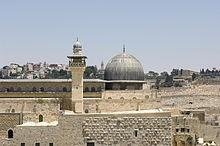Al-Jami 'al-Aqsa
Al-Jami 'al-Aqsa (Arabic: الجامع الاقصى) or Al-Qibli Mosque (Arabic: المسجد القبلي) [is one of the main buildings located within the southern Al-Aqsa Mosque complex with typical tin dome which is gray. Al-Jami 'al-Aqsa is often regarded as Al-Aqsa Mosque itself, although in fact the name of Al-Aqsa Mosque refers to the whole complex in which there are several important buildings; such as Al-Jami 'al-Aqsa itself, Ash-Shakhrah Dome, Mushalla Al-Marwani, Al-Mi'raj Dome, As-Silsilah Dome, An-Nabi Dome, and other buildings.
Jami 'Al Aqsa
الجامع الاقصى
Israel-2007-Jerusalem-Temple Mount-Al-Aqsa Mosque
General information
The location of Al Aqsa Mosque, Jerusalem
Geographic coordinates 31 ° 46'35 "LU 35 ° 14'8" BT / 31,77639 ° LU 35,23556 ° East
Affiliation of Islam
Old City District of Jerusalem
The ecclesiastical / organizational status of the mosque
Leadership of Waqf Foundation
Architectural description
This type of mosque architecture
The architectural style of early Islamic architecture, Mamluk
Laying the first stone 685 (first construction)
1033 (second construction)
Year completed 705 (first construction)
1035 (second construction)
Specification
North facade direction
Capacity 5000 [1]
Length of 83 meters (272 feet)
Width 56 meters (184 feet)
Dome 1
Tower 4
Tower height 37 meters (121 feet)
Limestone materials (outer walls, towers, facades), stalactites (towers), tin (domes), white marble (interior columns)
Al-Jami 'al-Aqsa was first built at the time of Umar bin Khaththab, although some opinions state that this mosque was built during the Umayyad Caliphate. After the earthquake of 746, the mosque was completely destroyed and rebuilt by the Abbasid Caliph Al-Mansur in 754, and redeveloped by his successor Al-Mahdi in 780. The subsequent earthquake destroyed most of Al-Jami 'al-Aqsa in 1033 , but two years later the Fatimid Caliph Ali azh-Zhahir rebuilt this mosque which still stands today.
In the various periodic renovations undertaken, various Islamic Caliphate dynasties have made additions to Al-Jami 'al-Aqsa and surrounding areas, among others on the domes, facades, pulpits, towers, and interior buildings. When the Crusaders conquered Jerusalem in 1099, they used this mosque as the palace and the Ash-Shakhrah Dome as a church, but the mosque's function was restored as it had been after Saladin took over the city's leadership. Renovations, refinements, and further additions were made in later centuries by the Ayyubid rulers, the Mamluks, the Ottomans, the Islamic High Council, and Jordan.
The burning of Al-Jami 'al-Aqsa on 21 August 1969 has prompted the establishment of the Organization of Islamic Conference which currently consists of 57 countries. The burning also caused the ancient pulpit of Saladin Al-Ayyubi to burn down. The Bashan Hashim dynasty of the Kingdom of Jordan has replaced it with a new pulpit done in Jordan [2], although some claim that the Jepara-made pulpit is used in this mosque.
